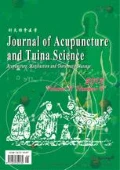摘要
目的
观察灸法结合拔罐疗法对运动性疲劳运动员主观体力感觉及血液生化指标的影响。
方法
将30 例体操运动员随机分为2 组, 大强度运动后, 治疗组15 例采用温和灸加拔罐治疗, 对照组15例休息30 min, 观察一次性大强度训练和周期性大强度训练前后运动员血清肌酸激酶(Creatine Kinase, CK)、 血尿素氮(Blood Urea Nitrogen, BUN)、 尿常规、 主观体力感觉评分表(Rating of Perceived Exertion, RPE)和SCL-90 症状自评量表的变化。
结果
大强度训练后, 治疗组升高的CK 水平恢复明显快于对照组。 SCL-90 症状自评量表分析结果显示治疗组运动员的人际关系优于对照组。 RPE 分析表明治疗组运动员的疲劳感觉轻于对照组。
结论
灸法结合拔罐疗法是消除运动性疲劳的一种有效的、 简便可行的方法。
Abstract
Objective
To observe the effect of moxibustion therapy plus cupping on perceived exertion and blood biochemical indicators in athletes with exercise-induced fatigue.
Methods
A total of 30 gymnasts were randomized into two groups. After intensive physical training, 15 cases in the treatment group were treated by mild moxibustion and cupping, whereas the other 15 cases in the control group took a 30-min break. After that, the Creatine Kinase (CK), Blood Urea Nitrogen (BUN), routine urinalysis, Rating of Perceived Exertion (RPE) and changes in Self-report Symptom Checklist 90 (SCL-90) were observed before and after one and periodic exercises.
Results
After intensive physical training, athletes in the treatment group obtained a faster recovery of elevated CK levels than those in the control group. Analysis on the SCL-90 has shown that athletes in the treatment group had better interpersonal relations than those in the control group. Additionally, RPE analysis has also indicated that athletes in the treatment group had milder fatigue than those in the control group.
Conclusion
Combined moxibustion with cupping is an effective and easy-to-operate method for exercise-induced fatigue.
References
Pang YH, Liu H, Li YY. Role of serum creatine kinase in sports medicine monitoring. Xiandai Zhongxiyi Jiehe Zazhi, 2004, 13(16): 2150.
Gui YH, Chen WB, Cao WY. Role of serum creatine kinase in monitoring exercise load endurance of weight-lifting athletes. Zhongguo Yundong Yixue Zazhi, 2004, 23(2): 180–184.
Ding LP, Xu L. Applied study on serum creatine kinase and blood urea nitrogen for training and pre-competition monitoring of martial arts athletes. Zhongguo Tiyu Keji, 2003, 39(10): 54–56.
Shi SS. Effect of point moxibustion on serum CK, BLA and sports ability during exercise. Nanjing Shida Xuebao: Ziran Kexue Ban, 2002, 25(1): 103–107.
Xiang ZY, Chen YW, Yu SB, Li HY, Zhang S, Wu XP. Experimental observation on acupuncture for exercise-induced fatigue. Shandong Tiyu Keji, 1998, 20(3): 25–27.
Hu XF, Yang WL. Physiological and biochemical diagnosis of exercise-induced fatigue in gymnasts. Shaanxi Shifan Daxue Jixu Jiaoyu Xuebao, 2006, 23(1): 125–127.
Xu JM. Medical Psychology. 2nd Edition. Shanghai: Shanghai Medical University Press, 1996: 183–191.
Luo L. Relationship between rating of perceived exertion (RPE) and incremented load running breather valve. Sichuan Tiyu Kexue, 1988, (3): 37–41.
Hongtai TT. Research advance of exercise-induced fatigue. Fujian Tiyu Keji, 1991, (10): 13–16.
Sun DL, Zhang Y, Chen DL. Research progress in sports fatigue prevented and treated by acupuncture. J Acupunct Tuina Sci, 2009, 7(2): 123–128.
Bao CL, Yuan P, Li LQ. Clinical observations on treatment of chronic fatigue syndrome with acupuncture based on yin-yang and qi-blood prescription of points. Shanghai Zhenjiu Zazhi, 2008, 27(6): 11–12.
Feng Z, Pang Y, Ye FW. TCM non-medicinal therapy for regulation and treatment of chronic fatigue syndrome. J Acupunct Tuina Sci, 2008, 6(6): 376–380.
Guo FY, Xu L. Preliminary study on treatment of chronic fatigue syndrome by herbal cake-separated moxibustion on Five-Zang Back-Shu Points. Shanghai Zhenjiu Zazhi, 2006, 25(10): 11–12.
Author information
Authors and Affiliations
Corresponding author
Rights and permissions
About this article
Cite this article
Sun, Dl., Zhang, Y., Chen, Dl. et al. Effect of moxibustion therapy plus cupping on exercise-induced fatigue in athletes. J. Acupunct. Tuina. Sci. 10, 281–286 (2012). https://doi.org/10.1007/s11726-012-0620-y
Received:
Published:
Issue Date:
DOI: https://doi.org/10.1007/s11726-012-0620-y

